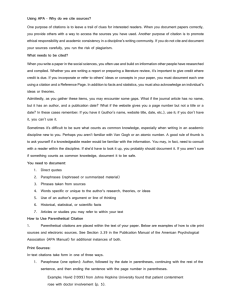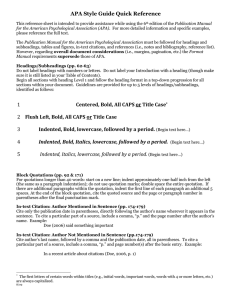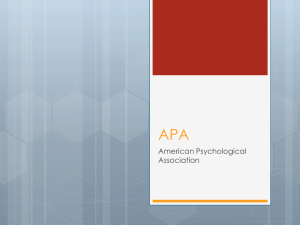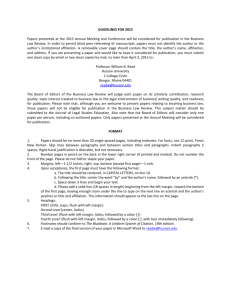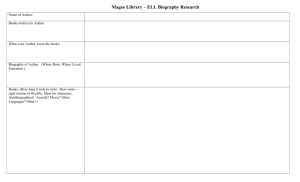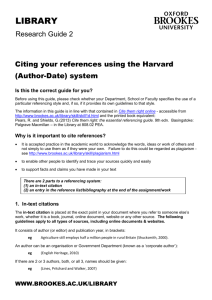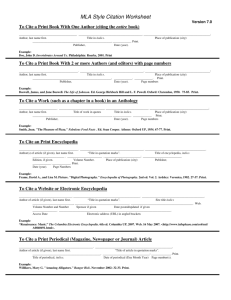doc - Brandeis University
advertisement
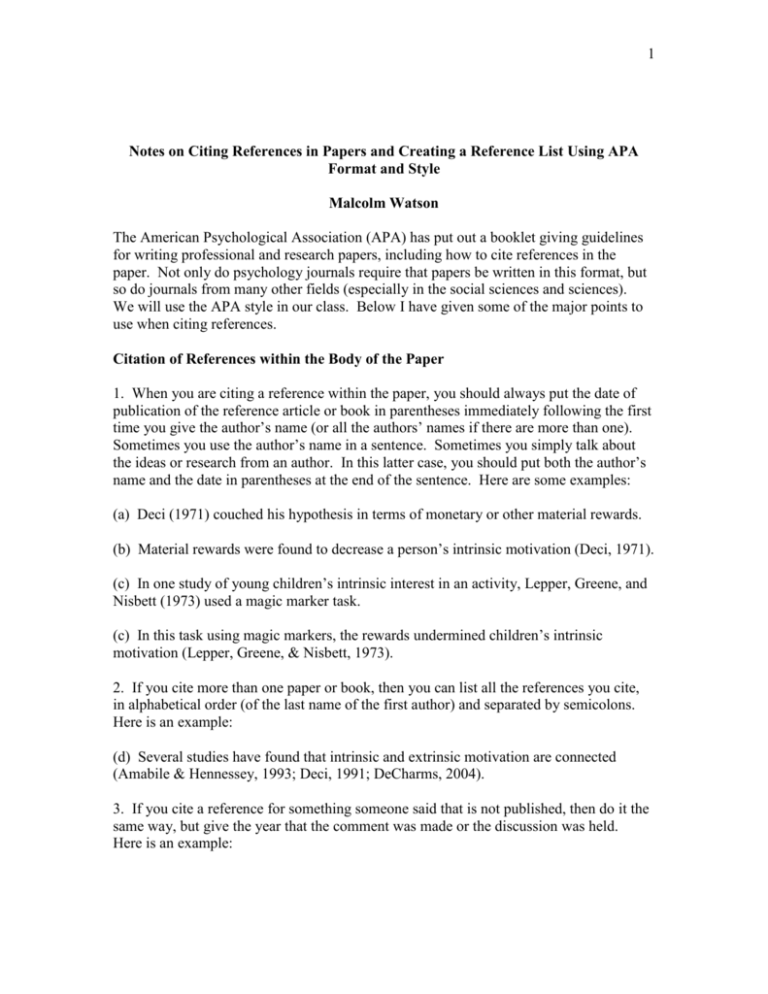
1 Notes on Citing References in Papers and Creating a Reference List Using APA Format and Style Malcolm Watson The American Psychological Association (APA) has put out a booklet giving guidelines for writing professional and research papers, including how to cite references in the paper. Not only do psychology journals require that papers be written in this format, but so do journals from many other fields (especially in the social sciences and sciences). We will use the APA style in our class. Below I have given some of the major points to use when citing references. Citation of References within the Body of the Paper 1. When you are citing a reference within the paper, you should always put the date of publication of the reference article or book in parentheses immediately following the first time you give the author’s name (or all the authors’ names if there are more than one). Sometimes you use the author’s name in a sentence. Sometimes you simply talk about the ideas or research from an author. In this latter case, you should put both the author’s name and the date in parentheses at the end of the sentence. Here are some examples: (a) Deci (1971) couched his hypothesis in terms of monetary or other material rewards. (b) Material rewards were found to decrease a person’s intrinsic motivation (Deci, 1971). (c) In one study of young children’s intrinsic interest in an activity, Lepper, Greene, and Nisbett (1973) used a magic marker task. (c) In this task using magic markers, the rewards undermined children’s intrinsic motivation (Lepper, Greene, & Nisbett, 1973). 2. If you cite more than one paper or book, then you can list all the references you cite, in alphabetical order (of the last name of the first author) and separated by semicolons. Here is an example: (d) Several studies have found that intrinsic and extrinsic motivation are connected (Amabile & Hennessey, 1993; Deci, 1991; DeCharms, 2004). 3. If you cite a reference for something someone said that is not published, then do it the same way, but give the year that the comment was made or the discussion was held. Here is an example: 2 (e) In a recent class at Brandeis University, Watson (2006) stated that a hydraulic model of motivation may not work for young children. 4. If you cite as a reference something you have taken from the Internet or on line, then again give the author or a title (if you don’t have an author) and the date you retrieved it. 5. With APA style, you don’t use footnotes to cite references, nor do you use the abbreviation: ibid. for a reference you have already cited. If necessary you just give the name and date again. Creation of a Reference List at then End of a Paper 1. In APA style, you don’t use bibliographies at the end of the paper. Instead you use a Reference List. After the last page of the paper, you should begin on a new page and entitle it as follows, centered at the top of the page: References 2. Then list every citation (reference) that you have cited in your paper. But do not list any references that you have not cited in your paper. The citations and the Reference list must agree exactly. 3. List the references in alphabetical order based on the last name of the first author. If an author has more than one reference that you have cited, list them from earliest date to latest date of publication. 4. Always spell out the last names of all authors, but just give the initials of first and middle names. 5. After the names, give the year of the publication (in parentheses). Then give the title of the paper. Then give the title of the journal where the article was found and the volume number and then the page numbers for the article. 6. If the reference is a book, then instead of the volume and pages, give the city of publication and the publisher’s name. 7. If you list a reference found on the Internet, give as much information as you can (including author and title and web site) so that a reader could also find the source. Also give the date you retrieved it because often web sources disappear and would no longer be available. 8. You can also put in a reference for something that was said or written but not published. Here are two examples: (a) Watson, M.W. (2006). Personal Communication in a class at Brandeis University. 3 (b) Watson, M.W. (2006). The development of creativity. Unpublished paper: Brandeis University. 9. Keep in mind that the main purposes of the References are to give credit for ideas and findings and to make it possible for the reader to also find those same references, either in books or journals or on line. Of course, personal communications or something said in a talk or in class will not be available to the reader and are therefore considered weaker references. 10. On the next page is a sample reference list that I hope will illustrate most of these points. Then on the last page is the same reference list but with my annotations made in bold and underlined to explain some things in the references. 4 References Arcus, D. (2001). Inhibited and uninhibited children: Biology in the social context. In T.D. Wachs & G.A. Kohnstamm (Eds.), Temperament in context (pp. 43-60). Mahway, NJ: Earlbaum. Asendorpf, J.B. (1991). Development of inhibited children’s coping with unfamiliarity. Child Development, 62, 1460-1474. Bernstein, J.Y., & Watson, M.W. (1997). Children who are targets of bullying: A victim pattern. Journal of Interpersonal Violence, 12, 483-498. Caspi, A., & Silva, P.A. (1995). Temperamental qualities at age 3 predict personality traits in young adulthood. Child Development, 66, 486-498. Lorenz, K. (1966). On aggression. New York: Bantam. Perry, D.G., Kusel, S.J., & Perry, L.C. (1988). Victims of peer aggression. Developmental Psychology, 24, 807-814. 5 References This heading is centered; then references are listed in alphabetical order Arcus, D. Last name given and then initial (2001). Year of publication given Inhibited and uninhibited children: Biology in the social context. Title of an article in a book given In T.D. Wachs & G.A. Kohnstamm (Eds.), Editors of the book given Temperament in context Title of the book given in italics (pp. 43-60). Page numbers of the article in the book given, not in italics Mahway, NJ: City of publication given Earlbaum. Name of publisher given Asendorpf, J.B. (1991). Development of inhibited children’s coping with unfamiliarity. Title of article in a journal given Child Development, Name of journal given in italics 62, Volume number of journal given in italics 1460-1474. Page numbers of article given, not in italics Bernstein, J.Y., & Watson, M.W. Two authors are listed in the order they appear on paper (1997). Children who are targets of bullying: A victim pattern. Journal of Interpersonal Violence, 12, 483-498. Caspi, A., & Silva, P.A. (1995). Temperamental qualities at age 3 predict personality traits in young adulthood. Child Development, 66, 486-498. Lorenz, K. (1966). On aggression. Title of a book given in italics New York: City of publication given Bantam. Name of publisher given Perry, D.G., Kusel, S.J., & Perry, L.C. Several authors are listed in the order found on paper (1988). Victims of peer aggression. Developmental Psychology, 24, 807-814.
